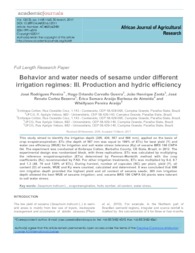Behavior and water needs of sesame under different irrigation regimes: III. Production and hydric efficiency.
Behavior and water needs of sesame under different irrigation regimes: III. Production and hydric efficiency.
Autoria: PEREIRA, J. R.; GUERRA, H. O. C.; ZONTA, J. H.; BEZERRA, J. R. C.; ALMEIDA, E. S. A. B. de; ARAÚJO, W. P.
Resumo: This study aimed to identify the irrigation depth (305, 436, 567 and 698 mm), applied on the basis of crop evapotranspiration- ETc (the depth of 567 mm was equal to 100% of ETc) for best yield (Y) and water use efficiency (WUE) for irrigation and soil water stress tolerance (Ky) of sesame BRS 196 CNPA G4. The experiment was conducted at Embrapa Cotton, Barbalha County, CE State, Brazil, in 2012. The experimental design was randomized block, with three replications. ETc was calculated by multiplying the reference evapotranspiration (ETo) determined by Penman-Monteith method with the crop coefficients (Kc) recommended by FAO. For other irrigation treatments, ETc was multiplied by 0.4, 0.7 and 1.3 (40, 70 and 130% of ETc). During harvest, number of capsules (NC) per plant, yield (Y), oil content (O) of seeds, WUE and Ky were counted, calculated and determined. It was concluded that 698 mm irrigation depth provided the highest yield and oil content of sesame seeds; 305 mm irrigation depth allowed the best WUE of sesame irrigation; and, sesame BRS 196 CNPA G4 plants were tolerant to soil water stress.
Ano de publicação: 2017
Tipo de publicação: Artigo de periódico
Unidade: Embrapa Algodão
Palavras-chave: Evapotranspiration, Evapotranspiração, Gergelim, Irrigation, Irrigação, Oil content, Sesamum indicum, Water stress
Observações
1 - Por padrão são exibidas publicações dos últimos 20 anos. Para encontrar publicações mais antigas, configure o filtro ano de publicação, colocando o ano a partir do qual você deseja encontrar publicações. O filtro está na coluna da esquerda na busca acima.
2 - Para ler algumas publicações da Embrapa (apenas as que estão em formato ePub), é necessário ter, no celular ou computador, um desses softwares gratuitos. Sistemas Android: Google Play Livros; IOS: iBooks; Windows e Linux: software Calibre.
Acesse outras publicações
Acesse a Base de Dados da Pesquisa Agropecuária (BDPA) para consultar o acervo completo das bibliotecas da Embrapa.

